Our research on data governance tools explores the top vendors in data security, data intelligence, and master data management (MDM), focusing on their key capabilities such as big data processing. To illustrate how data-driven companies like Procter & Gamble (P&G) and Uber use these tools, we compiled 10+ data governance case studies:
| Company | Real-life example |
|---|---|
| Procter & Gamble (P&G) | Deployed a data quality software to manage unique SAP instances. |
| Uber | Enhanced data governance with federated real-time queries. Processed petabytes of data. |
| JPMorgan Chase | Deployed a decentralized data mesh architecture for improved data tracking, auditing. |
| Panasonic | Improved data lineage and role-based governance. |
| Unilever | Partnered with MDM solution providers to centralize data points, used low-code tools for MDM control. |
| Q2 | Used data tokenization and real-time monitoring, to adhere PCI DSS compliance. |
| McGraw-Hill Education (MHE) | Used product tagging, and BI for enhanced data governance. |
| GE Aviation | Launched a self-service data governance framework for data analysis, and task automation. |
| KPMG LLP | Consolidated disparate data sources, automated data tagging. |
| Holiday Inn Club Vacations | Used cloud-based data governance tools to consolidate data from 7 systems, scaled data ingestion. |
| A large U.S. manufacturer | Deployed a data security platform for sensitive data discovery, and classification. |
| A large financial services company | Built a vendor data registry platform to track data usage. |
What is data governance?
Data governance is a strategy for developing internal data standards and policies that govern who has access to data, and how data is utilized in business operations and analytics applications.
1. Procter & Gamble (P&G): Improved master data management
Procter & Gamble (P&G) faced a significant challenge in managing its data across global and regional operational systems. The company’s master data management (MDM) and metadata were not properly aligned with its operational reporting systems.
Challenges
- Complex data systems: P&G’s data systems were complicated, with 48 SAP instances in various downstream application servers, making identifying and reconciling data errors time-consuming.
- Lack of central data control: P&G had several separate business units that started using their own data management processes, and the company needed a centralized data quality platform and toolset.
Solutions and outcome
P&G’s data governance team deployed a data quality software to improve the quality and control of their master data, which included over 32 unique SAP instances and billions of records.
Additionally, a data quality assurance and control (DQA/DQC) plan was created to phase out some existing third-party technology.
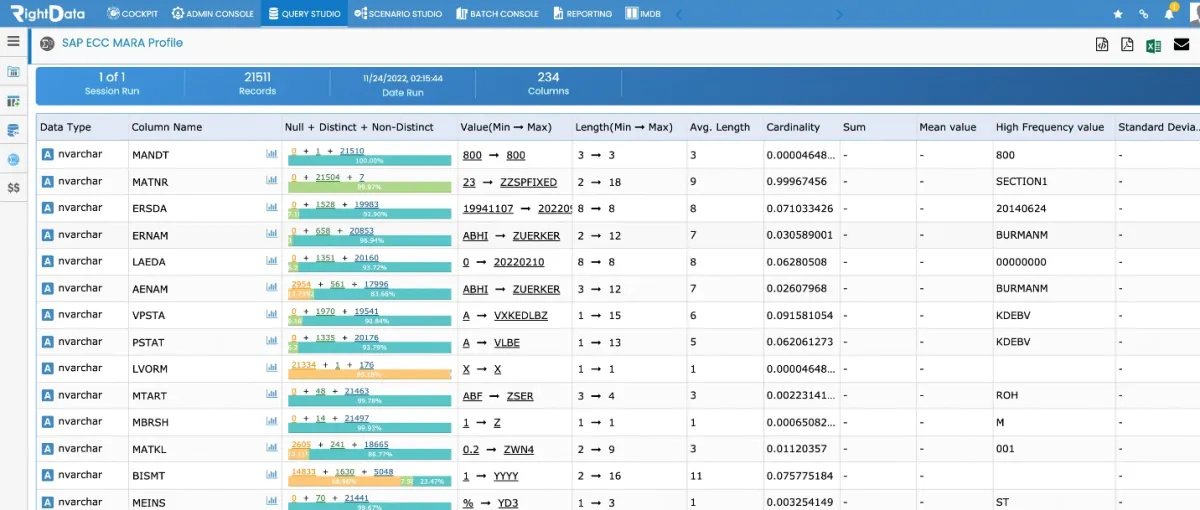
- Improved productivity: Before implementation, analysts would download all data offline once a week, integrate it from numerous sources, and manually resolve discrepancies and variances. The automated processes saved time for data stewards and reduced manual errors.
- Reduced operational risks: Minimized data leakage and duplication, lowering compliance and financial risks.
- Actionable insights via dashboards: Management had timely access to health reports and performance metrics.1
Read more: AI data governance, open-source data governance tools.
2. Uber: Processed petabytes of data
Uber, the ride-hailing giant, operates in over 10,000 cities and provides over 18 million rides/day. Uber stores 256 petabytes of data and processes 35 petabytes every day. They support 12,000 monthly active analytics users, who conduct over 500,000 daily queries.
Challenges
- Data volume and complexity: With over 18 million trips per day and a data footprint exceeding 256 petabytes, Uber needed a way to manage and analyze massive datasets in real-time while maintaining global performance.
- Traditional databases limitations: Traditional databases and data lakes failed to meet Uber’s performance needs, particularly for real-time or near-real-time decision-making.
- Scalability concerns: As the business grew, the scale of required analytics also expanded. Traditional systems struggled with managing concurrent queries at a petabyte scale.
- Performance and query speed: Uber needed a solution that could handle high-volume data queries quickly and efficiently.
Solutions and outcome
Uber deployed Presto as a distributed SQL query engine to handle their massive data analytics needs. Uber’s new data ecosystem, enabled the company to process petabytes of data, support diverse analytical use cases, and make informed decisions at scale:
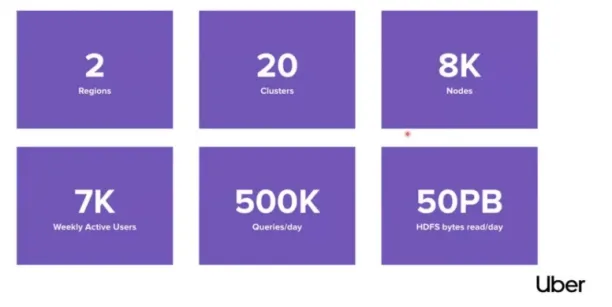
Source: Uber2
Here’s how the solution became integral to Uber’s data governance strategy:
- Federated queries: Enabled Uber to query data from multiple sources (on-premises or in the cloud).
- Workload management for data quality: Uber used granular workload management strategies, including isolating traffic based on query types (speed or accuracy).
- Real-time queries for data analytics: Uber integrated real-time queries by connecting to “Apache Pinot”, a distributed datastore. This integration allowed Uber to process live data with low latency.
- Custom data governance functions: The solution enabled Uber to define its functions. For example, tied closely to their digital business, Uber has created their geospatial functions.3
3. JPMorgan Chase: Built a data mesh architecture
A data mesh architecture is a decentralized technique that allows domain teams to independently analyze cross-domain data. It centralizes disparate data sources and links them through centrally managed data sharing and governance guidelines.
Challenges
JPMorgan, the largest bank in the US, needed an architecture where individual data product owners have control over their data lakes, allowing them to make risk-based decisions for their data while maintaining cross-enterprise visibility through a data catalog.
- Data silos: Dispersed data across different business lines and functions made it challenging to discover, access, and share data effectively and securely across the organization.
- Complexity in permissions: The company was challenged to manage fine-grained access control with multiple data sources and consumer needs.
- Lack of cross-enterprise visibility: JPMorgan Chase faced difficulty tracking and monitoring how data was used across the organization.
Solutions and outcome
JPMorgan Chase implemented a data mesh architecture, where data is distributed across various business units and managed by the teams closest to it. In the data mesh architecture, In the data mesh architecture:
- Data flows are tracked and logged via the mesh catalog, allowing data product owners to see exactly how their data is being used.
- Data product owners curated the data for reporting purposes within their dedicated data lakes.
- Data consumers (such as reporting teams) accessed data through the enterprise data catalog.
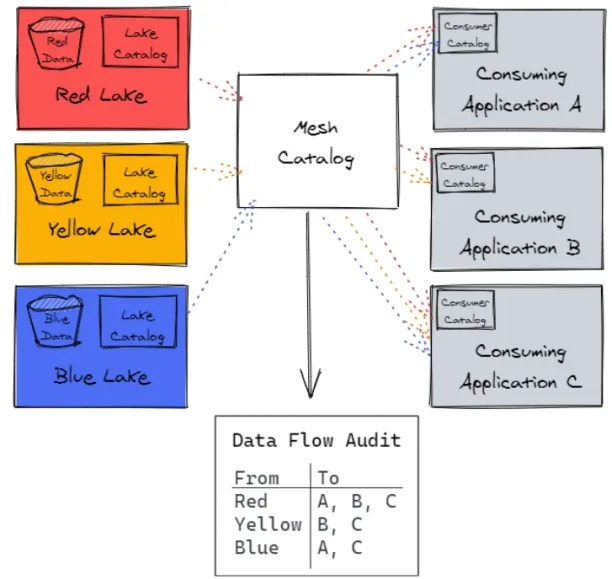
Source: AWS4
JPMorgan Chase also deployed a data mesh catalog (AWS Glue Data Catalog). This catalog enabled data cataloging for cross-enterprise visibility. This:
- Improved data tracking and auditing: Data product owners can ensure that data management practices are aligned with regulatory requirements and internal policies.
- Enhanced data quality control: Auditing data consumption enables the detection of inconsistencies, errors, or outdated data.5
4. Panasonic: Improved data lineage and traceability
Panasonic’s Smart Mobility Office is challenged with managing massive volumes of data as it focuses on developing transportation safety solutions.
Challenges
- Data discovery & accessibility issues: Panasonic had large volumes of connected IoT, weather, and geospatial data (3TB per week). The company lacked a clear source of truth.
- Role-based data controls: The company needed structured schemas for business units to manage role-based access to prevent unnecessary data exposure.
Solutions and outcome
Source: 6
- Centralized data hub: Panasonic deployed Secoda, a centralized data governance platform, to leverage data lineage by tracking and visualizing data flow from origin to destination. The company also created a structured documentation system to explain logic, calculations, and dashboard insights.
- Role-based data governance: RBAC capabilities in Secoda ensured that users access only data relevant to their role. This established business-unit-specific schemas, improving structured data ingestion.7
5. Unilever: Built a data governance framework for vendor onboarding
Unilever operates in nearly 190 countries, with over 400 brands, thousands of suppliers and customers, and over one billion global consumers. They needed a master data management strategy that could handle complexity and scalability.
Challenges
- Complex global operations: Managing master data across 190 countries, over 400 brands, thousands of suppliers and customers, and more than a billion consumers.
- Separated data management: The lack of a unified master data management (MDM) system leads to inefficiencies and potential data inconsistencies.
- Need for efficient vendor onboarding: The company required a streamlined HR onboarding process for vendors to maintain operational efficiency across geographies.
Solutions and outcome
Unilever partnered with a master data management solutions management company to foster the digitization of its management operations across vendor, customer, and product channels. Thus, the company implemented a new vendor data management process in almost 40% of the countries.
The following outcomes have been achieved:
- Centralized and documented data points: Data points from diverse categories and locations were consolidated throughout its record systems and back-end applications, resulting in increased efficiency, data quality, and speed.
- No-code data management: With the new deployment Unilever used low-code capabilities to enable more control over its master data.
- Streamlined HR operations: Onboarding time for vendors decreased to hours instead of days.8
6. Q2’s Biller Direct App: Complied PCI DSS regulations
Q2 is a publicly listed Austin, Texas-based financial services company that offers digital banking and lending solutions to banks, credit unions, alternative finance, and fintech organizations.
Challenges
Q2 was already operating existing data centers and cloud environments, which were not initially designed with PCI DSS compliance. They needed to ensure that existing data centers and cloud operations would not be exposed to the PCI DSS scope while still securely managing the new data associated with the Biller Direct app.
- PCI DSS certification: Q2’s new Biller Direct app made them accountable for a large amount of sensitive payment data (250,000+ new credit card numbers) that would be subject to PCI DSS.
- Creating a separate environment: To address both the compliance requirements and the need to scale effectively, Q2 required a separate cloud environment dedicated to handling sensitive payment data. This was crucial to mitigate risks and ensure that only the necessary infrastructure and data systems were subject to PCI DSS compliance requirements.
Solutions and outcome
Q2 leveraged ALTR’s data security as a service to ensure the “Biller Direct” application could meet PCI Level 1 certification.
- Data tokenization: ALTR enabled transparent tokenization, which means Q2 replaced sensitive data (e.g., credit card numbers) with non-sensitive placeholders (tokens) with no intrinsic value. And, linked to the original data in a secure manner. Thus, the application or database will treat the tokenized data as the original data.
- Real-time monitoring and policy enforcement: ALTR’s platform provided real-time breach detection, data access tracking, and policy enforcement capabilities. These features helped mitigate risks from credentialed threats or SQL injection attacks, ensuring compliance with PCI DSS requirements.9
Fragmentation and encoding schemes provide seamless delivery of tokens:
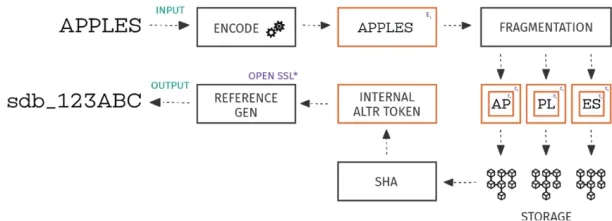
Source: AWS, ALTR10
7. McGraw-Hill Education (MHE): Enhanced collaboration with product tagging
McGraw Hill is an American learning science company that offers educational content, software, and services to students and educators.
Challenges
- Fragmented data governance: MHE needed to manage data governance across multiple systems, including on-premises mainframes, Oracle-based systems, and cloud applications like Salesforce.
- Data quality issues: There was a need to improve the quality of the data used for Business Intelligence (BI) and reporting.
Solutions and outcome
MHE implemented cloud-native Informatica Axon Data Governance software. The implementation included integrating data from various sources such as on-premises systems and cloud applications.
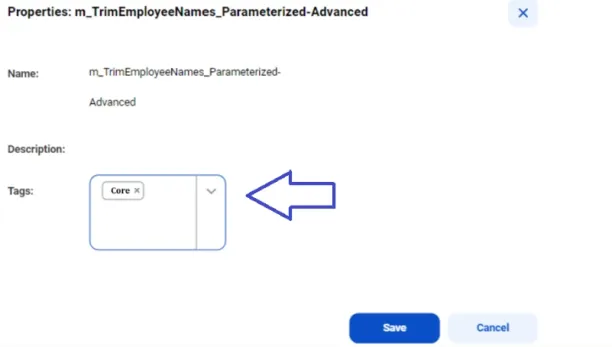
Source: Informatica11
- Enhanced collaboration with product tagging: The new software allowed MHE business divisions to categorize and tag their educational products more clearly.
- Improved data governance: “We are tracking data quality week by week. With better data and better BI, we can run the business more efficiently.” said Pape, director of data governance at MHE.
- Eliminated excessive support requests: The implementation provided several connectors for accessing cloud data. This eliminated support requests, enabling administrators to focus on more strategic projects.12
8. GE Aviation: Enabled data accessibility
GE Aviation division is a branch of General Electric’s global network, one of the world’s largest aircraft engine manufacturers. The company faced data governance challenges related to inconsistent data usage and siloed systems.
Challenges
- Lack of operational efficiency: The traditional systems lacked operational efficiency, causing supply chain bottlenecks. For example, it was challenging to transform sensor data into actionable analytics for customers.
- Data access: Operations teams faced difficulties obtaining data compared to other departments.
- Data complexity: Engineers struggled with analyzing large, complex datasets using traditional tools like Excel and Minitab.
- Manual and time-consuming processes: Finance teams relied on Excel for complex reporting, requiring significant effort.
Solutions and outcome
GE Aviation established a centralized, cross-functional team to manage the data governance initiatives of its 1,800+ users globally. The company launched a data governance program that includes:
- A self-service data governance framework where employees can easily access and utilize data for insights without heavy reliance on IT teams.
- A self-service data analysis and model-building platform Dataiku to allow users to discover, and govern data across the organization.
The following outcomes have been achieved:
- Improved automation: The self-service data program streamlined processes, enabling quicker access to data and automating trivial tasks.
- Robust governance: Data products were governed using a data intelligence platform for proper documentation, data ownership, and workflow approvals.
- Self-service data usage: The program helped employees leverage self-service data initiatives for tool administration or process automation.13
9. KPMG LLP: Centralized data for digital transformation
KPMG LLP is the U.S. branch of the KPMG global network of independent professional services businesses that provide audit, tax, and advisory services. KPMG operates in 143 countries and territories, with over 273,000 employees
Challenges
- Lack of central data management: KPMG LLC needed to consolidate data sources into a single platform.
- Data quality and transparency issues: KPMG LLC lacked high-quality, transparent customer data for digital capabilities.
Solutions and outcome
KPMG aimed to create a centralized MDM program to analyze data across member firms. The goal was to eliminate duplicate and inconsistent customer and financial data and standardize it.
Here’s a summary of the key outcomes of KPMG’s implementation of the MDM program :
Operational efficiency
- Enhanced data reliability: Centralized data sources into a unified, trusted storage system.
- Streamlined reporting: Management reporting required minimal manual intervention.
Strategic benefits
- Enhanced analytics: High-quality data served as a foundation for accurate accounting analytics, benefitting Audit, Tax, and Advisory practices
- Automated data tagging and handling: Using data governance tools enabled the automated tagging and handling, this helped KPMG LLC to prioritize customer privacy and store data in standardized formats to adhere to compliance.14
10. Holiday Inn Club Vacations: Improved data visibility
Holiday Inn Club Vacations (HICV) is a family-focused travel brand operating over 30 resorts across the U.S. and Mexico.
Challenges
- High expectations for personalization: Travellers expect highly personalized experiences, such as unique recommendations and tailored vacation ideas, and a seamless experience across both online and offline channels.
- Operational shifts: The company leadership demanded a framework that focuses on post-resort marketing strategies to nurture and build lifetime loyalty.
Meeting these changing needs necessitates a customer-centric culture supported by high-quality data.
Solutions and outcome
Holiday Inn Club Vacations used cloud master data management, data governance, and data quality solutions to unify customer data with increased data visibility for each member.
Streamlined data integration:
- Consolidated data from 7 main systems into a cloud-based platform.
- Leveraged low/no-code capabilities to integrate 350,000+ customer profiles from the main systems.
Secure data management:
- Cloud-native architecture enabled scaling of data ingestion.
- Verified member profiles were seamlessly integrated into data pipelines, reducing compliance risks.
Automation:
- Used metadata intelligence, data lineage, and natural language processing to reduce manual tasks.15
11. U.S. manufacturer: Automated sensitive data discovery & classification
A large-scale U.S. manufacturer needed to manage their data. The company’s historical Windows system contained:
- 9+TB of data
- 1+ million folders
- 11+ million files
- 9+ million permissions.
Challenges
The manufacturer conducted a data risk assessment that revealed a critical vulnerability in the company’s environment, here are the challenges discovered:
- Lack of data security: All employees were exposed to an HR payroll folder containing over 90,000 Social Security numbers.
- Gaining visibility into 9+ TB of data: The company managed a vast amount of data (1+ million folders), making it difficult to track sensitive information.
- Protecting vulnerable data from ransomware: The company’s data assets were prone to ransomware.
Solutions and outcome
New data governance platform: The company deployed the data security platform to address these vulnerabilities. The platform offered several key capabilities:
- Automated sensitive data discovery and classification: Including Personally Identifiable Information (PII), intellectual property, and regulated data.
- Visualization of permissions: Provided detailed visibility into who had access to data and where it was overexposed.
- Auditing: Auditing of activity across Active Directory and core data stores.
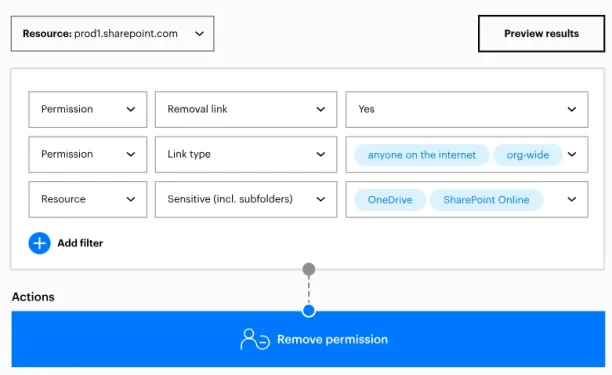
Source: Varonis16
After deploying the new data governance platform and conducting a data risk assessment following outcomes have been achieved:
- Enhanced monitoring and alerting: The IT team used the platform to set up alerting mechanisms to detect suspicious activity and vulnerabilities.
- Faster incident response: The alerts ensured that the incident response team could act quickly when a security breach was detected.17
12. A large financial services company: Launched a data registry platform
A large financial services company partnered with an asset management and data analytics team to establish a new data platform registry.
Challenges
- Lack of accountability: The financial service company couldn’t allow permissions depending on contractual (information barrier) and disclosure requirements.
- No traceability: The company couldn’t integrate registry data with file activity from drop zones, shares, APIs, and other sources.
- Lack of reporting and visualizations: The reporting and visualization capabilities were insufficient, making it difficult to assist analytics in managing, monitoring, and driving insights into data usage.
Solutions and outcome
The outsourced team built a vendor data registry platform to consolidate inventory of 22,000 feeds, mapping 127 services across 97 vendors, and helping improve the capacity to track, monitor, and govern data usage.
- Phase 1: Data modeling: Designed a vendor registry data model and metadata framework for improved governance and usability.
- Phase 2: Platform improvements:
- Cloud-based integrations: Leveraged cloud services to build a platform integrated with the client’s existing ecosystem.
- API Integration: Integrated the registry platform with firmwide APIs for enhanced connectivity and automation.
- Phase 3: Data governance and reporting: Built capabilities for detailed reporting, data lineage tracking, and analytics.18
Key benefits of data governance
1. Gain more value from enterprise data
Data governance may assist in ensuring data integrity, accuracy, completeness, and consistency by establishing a framework that promotes robust data stewardship.
For example, data lineage technologies can assist data owners track data throughout its lifecycle, including any changes the data takes during extract, transform, and load (ETL).
2. Establish a single source of truth (SSOT)
A correctly managed data system can provide a single source of truth throughout an organization. When all parties use the same data sets, data-driven decision-making becomes simpler.
Combining data definitions and metadata into a single data catalog can help eliminate misinformation and inefficiencies. Thus data governance frameworks can serve as the foundation for self-service solutions that ensure uniform data and access across the enterprise.
3. Ensure regulatory compliance
Data governance policies frequently include operations that make it easier to comply with government regulations governing sensitive data and privacy, such as:
- EU’s General Data Protection Regulation (GDPR),
- United States Health Insurance Portability and Accountability Act (HIPAA)
- Payment Card Industry Data Security Standards (PCI DSS).
4. Securely utilize data for AI efforts
According to an IDC survey, only 45% of respondents reported having “rules, policies, and processes to enforce their responsible AI principles” to defend against security breaches and regulatory risk.19
Data governance is essential for managing risks and supporting AI governance by ensuring high-quality, secure data for AI and ML initiatives. Effective governance helps prevent sensitive personal data from being misused and ensures compliance with regulations, enabling the responsible use of AI.
5. Facilitate more accurate data analytics
Accurately managed data enables beneficial initiatives such as business intelligence reporting.
For example, properly profiling data—reviewing and cleansing data to better comprehend its structure—can help make sense of the connection between various data sets and sources.
What is a data processing agreement (DPA)?
In a data governance program, a data processing agreement defines how data processors must handle, protect, and limit use of personal data in line with your organization’s privacy and compliance policies.
It ensures:
- Clear roles and responsibilities between controller and processor
- Technical and organizational policies are in place
- Compliance with frameworks like GDPR, CCPA, HIPAA, or ISO/IEC 27001
- Support for data subject rights (e.g., deletion, correction)
- Accountability in incident response, audits, and cross-border transfers
Further reading
External Links
- 1. MDM Data Quality Assurance & Control (P&G). RightData
- 2. https://www.uber.com/en-TR/blog/presto-express/
- 3. Presto® Express: Speeding up Query Processing with Minimal Resources | Uber Blog.
- 4. https://aws.amazon.com/tr/blogs/big-data/how-jpmorgan-chase-built-a-data-mesh-architecture-to-drive-significant-value-to-enhance-their-enterprise-data-platform/
- 5. How JPMorgan Chase built a data mesh architecture to drive significant value to enhance their enterprise data platform | AWS Big Data Blog.
- 6. Panasonic uses Secoda to connect their data infrastructure.
- 7. Panasonic uses Secoda to connect their data infrastructure.
- 8. Unilever transforms master data management with Pega | Pega.
- 9. https://aws.amazon.com/tr/blogs/apn/how-altr-helped-q2s-biller-direct-offering-become-level-1-pci-dss-certified-in-30-days/
- 10. How ALTR Helped Q2’s Biller Direct Offering Become Level 1 PCI DSS Certified in 30 Days | AWS Partner Network (APN) Blog.
- 11. Creating tags.
- 12. File Not Found | Informatica. Informatica
- 13. ”GE Aviation: From Data Silos to Self-Service“. GE Aviation. Retrieved on December 2024
- 14. KPMG’s AI-Ready Data Transformation with Informatica | Informatica. Informatica
- 15. How HICV Uses MDM for Customer Data | Informatica. Informatica
- 16. Data Access Governance | Varonis.
- 17. https://info.varonis.com/hubfs/Web%20Assets/Website_Reboot/Case_Studies/EN-Case-Studies/CaseStudy-US-County-Ransomware.pdf?hsLang=en
- 18. Case study: Financial services firm improves data governance | EY - US. MIT OpenCourseWare
- 19. IBM Registration form.


Comments
Your email address will not be published. All fields are required.